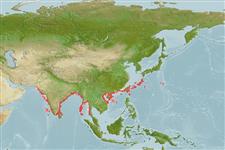Élasmobranches (requins et raies) (sharks and rays) >
Carcharhiniformes (Ground sharks) >
Carcharhinidae (Requiem sharks)
Etymology: Glyphis: Tautonymous with Carcharias glyphis Müller & Henle 1839. (See ETYFish); gangeticus: -icus (Gr.) belonging to: Ganges River, India, where Müller and Henle mistakenly thought it occurred. (See ETYFish).
More on authors: Müller & Henle.
Environment: milieu / climate zone / depth range / distribution range
Écologie
marin; eau douce; saumâtre démersal; amphidrome (Ref. 51243). Tropical; 30°N - 8°N, 65°E - 143°E
Indo-West Pacific: north Indian Ocean, Indus River outside Karachi, Pakistan to Bangladesh, Myanmar, Thailand and Borneo.
Taille / Poids / Âge
Maturity: Lm ? range ? - ? cm
Max length : 204 cm TL mâle / non sexé; (Ref. 244)
Biology poorly known. But its minute eyes suggest that it may be adapted to turbid water with poor visibility, as in large tropical rivers and muddy estuaries. Newborn specimens are from 56 to 61 cm long. Viviparous (Ref. 50449). Its notoriety may have stemmed from its widespread confusion with C. leucas. But this species is potentially dangerous as well because of its size and large teeth, though its reputation as a man-eater is still unproven.
Life cycle and mating behavior
Maturité | Reproduction | Frai | Œufs | Fécondité | Larves
Viviparous, placental (Ref. 50449). Distinct pairing with embrace (Ref. 205).
Compagno, L.J.V., 1984. FAO Species Catalogue. Vol. 4. Sharks of the world. An annotated and illustrated catalogue of shark species known to date. Part 2 - Carcharhiniformes. FAO Fish. Synop. 125(4/2):251-655. Rome: FAO. (Ref. 244)
Statut dans la liste rouge de l'IUCN (Ref. 130435)
Menace pour l'homme
Traumatogenic
Utilisations par l'homme
Pêcheries: pêcheries vivrières
Plus d'informations
Taille/ÂgeCroissanceLongueur-poidsLongueur-longueurFréquences de longueursMorphométrieMorphologieLarvesDynamique des populations larvairesRecrutementAbondanceBRUVS
RéférencesAquacultureProfil d'aquacultureSouchesGénétiqueElectrophoresesHéritabilitéPathologiesTraitementNutrientsMass conversion
CollaborateursImagesStamps, Coins Misc.SonsCiguateraVitesseType de nageSurface branchialeOtolithesCerveauxVision
Outils
Articles particuliers
Télécharger en XML
Sources Internet
Estimates based on models
Preferred temperature (Ref.
123201): 24.6 - 28.1, mean 26.3 °C (based on 141 cells).
Phylogenetic diversity index (Ref.
82804): PD
50 = 0.5312 [Uniqueness, from 0.5 = low to 2.0 = high].
Bayesian length-weight: a=0.00468 (0.00218 - 0.01003), b=3.09 (2.92 - 3.26), in cm total length, based on LWR estimates for this (Sub)family-body shape (Ref.
93245).
Niveau trophique (Ref.
69278): 4.2 ±0.7 se; based on size and trophs of closest relatives
Résilience (Ref.
120179): Très faible, temps minimum de doublement de population supérieur à 14 ans (Assuming Fec<10).
Fishing Vulnerability (Ref.
59153): Very high vulnerability (90 of 100).
